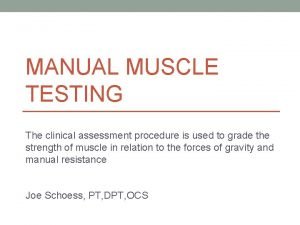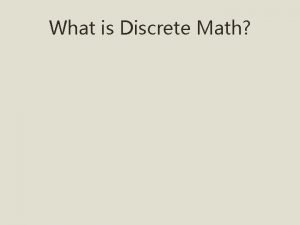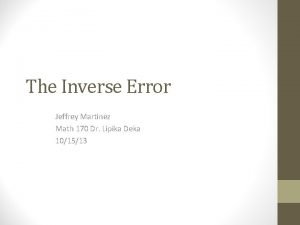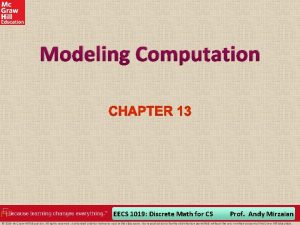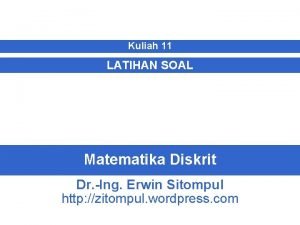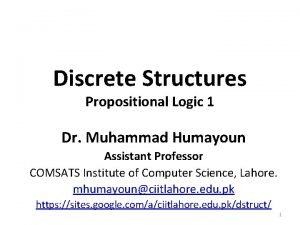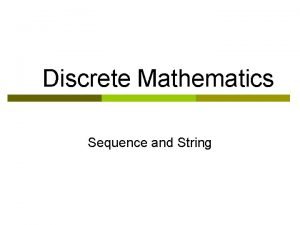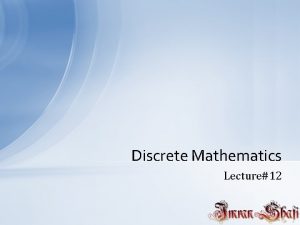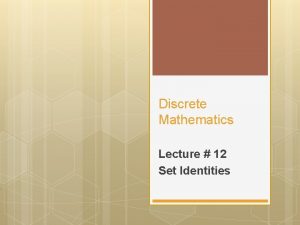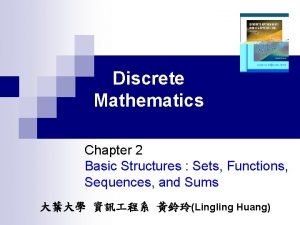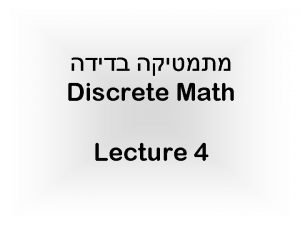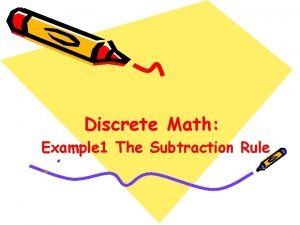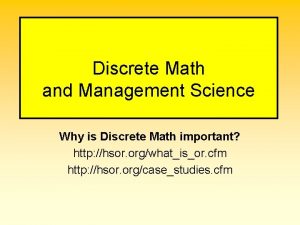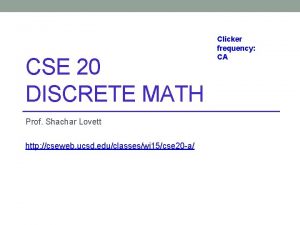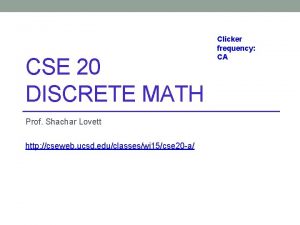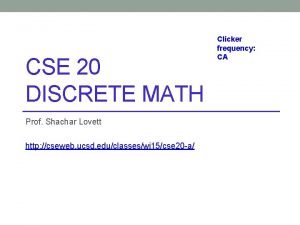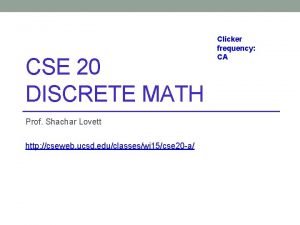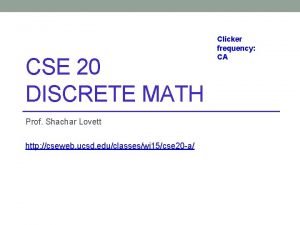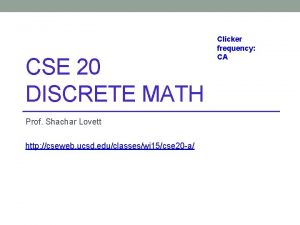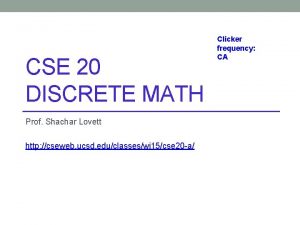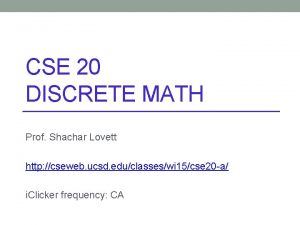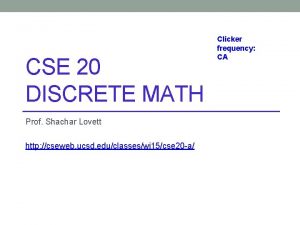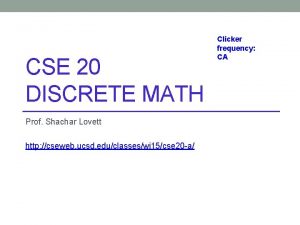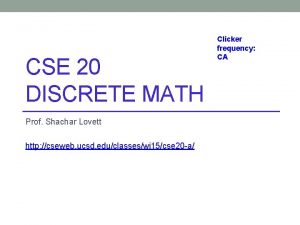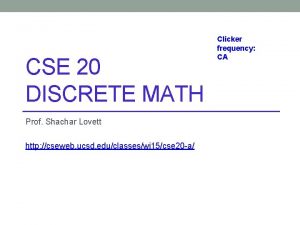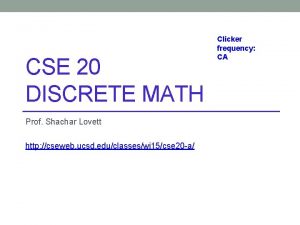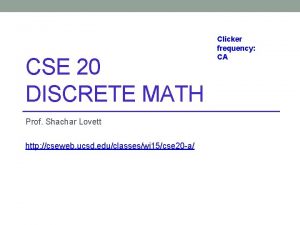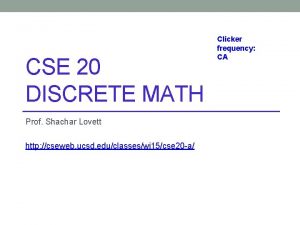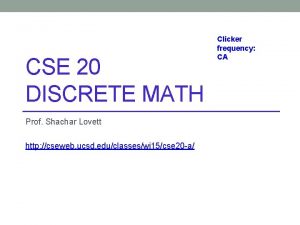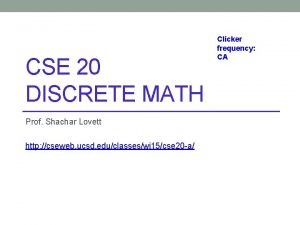CSE 20 DISCRETE MATH Prof Shachar Lovett http



















- Slides: 19

CSE 20 DISCRETE MATH Prof. Shachar Lovett http: //cseweb. ucsd. edu/classes/wi 15/cse 20 -a/ Clicker frequency: CA

Todays topics • Knights and knaves

Knights and Knaves • Knights and Knaves scenarios are somewhat fanciful ways of formulating logic problems • Knight: everything a knight says is true • Knave: everything a knave says is false 2+2=4 2+2=3

You approach two people, you know the on the left is a knave, but you don’t know whether the on the right is a knave or a knight. • Left: “Everything she says is true. ” • Right: “Everything I say is true. ” • What is she (the on the right)? A. Knight B. Knave C. Could be either/not enough information D. Cannot be either/situation is contradictory

You approach one person, but you don’t know whether he is a knave or a knight. • Mystery person: “Everything I say is true. ” • What is he? A. Knight B. Knave C. Could be either/not enough information D. Cannot be either/situation is contradictory

You approach one person, but you don’t know whether she is a knave or a knight. • Mystery person: “Everything I say is false. ” • What is she? A. Knight B. Knave C. Could be either/not enough information D. Cannot be either/situation is contradictory

You meet 3 people: A: “At least one of us is a knave. ” B: “At most two of us are knaves. ” [C doesn't say anything] • This is a really tricky one, but take a moment to see if you can determine which of the following is a possible solution: A. A: Knave, B: Knave, C: Knave B. A: Knight, B: Knight, C: Knight C. A: Knight, B: Knight, C: Knave (Suggestion: eliminate wrong choices rather than trying to solve the puzzle directly. In your groups: please discuss logic for eliminating choices. )

Proof by Contradiction Steps • What are they? A. 1. Assume what you are proving, 2. plug in definitions, 3. do some work, 4. show the opposite of what you are proving (a contradiction). B. 1. Assume the opposite of what you are proving, 2. plug in definitions, 3. do some work, 4. show the opposite of your assumption (a contradiction). C. 1. Assume the opposite of what you are proving, 2. plug in definitions, 3. do some work, 4. show the opposite of some fact you already showed (a contradiction). D. Other/none/more than one.

You meet 3 people: A: “At least one of us is a knave. ” B: “At most two of us are knaves. ” [C doesn't say anything] • A: Knight, B: Knight, C: Knave • Zeroing in on just one of the three parts of the solution, we will prove by contradiction that A is a knight.

A: “At least one of us is a knave. ” B: “At most two of us are knaves. ” [C doesn't say anything] Thm. A is a knight. Proof (by contradiction): Assume not, that is, assume A is a knave. Try it yourself first!

A: “At least one of us is a knave. ” B: “At most two of us are knaves. ” [C doesn't say anything] Thm. A is a knight. Proof (by contradiction): Assume not, that is, assume A is a knave. Then what A says is false. Then it is false that at least one is a knave, meaning zero are knaves. So A is not a knave, but we assumed A was a knave, a contradiction. So the assumption is false and theorem is true. QED.

You meet 3 people: A: “At least one of us is a knave. ” B: “At most two of us are knaves. ” [C doesn't say anything] • A: Knight, B: Knight, C: Knave • Zeroing in on the second of the three parts of the solution, we will prove by contradiction that B is a knight.

A: “At least one of us is a knave. ” B: “At most two of us are knaves. ” [C doesn't say anything] Thm. B is a knight. Proof (by contradiction): Assume not, that is, assume B is a knave. Try it yourself first!

A: “At least one of us is a knave. ” B: “At most two of us are knaves. ” [C doesn't say anything] Thm. B is a knight. Proof (by contradiction): Assume not, that is, assume B is a knave. Then what B says is false, so it is false that at most two are knaves. So it must be that all three are knaves. Then A is a knave. So what A says is false, and so there are zero knaves. So B must be a knight, but we assumed B was a knave, a contradiction. So the assumption is false and theorem is true. QED.

A: “At least one of us is a knave. ” B: “At most two of us are knaves. ” [C doesn't say anything] Thm. B is a knight. Proof (by contradiction): Assume not, that is, assume B is a knave. Then what B says is false, so it is false that at most two are knaves. So it must be that all three are knaves. We didn’t need Then A is a knave. this step So what A says is false, and so there are zero knaves. because we But all three are knaves and zero are knaves is a contradiction. had already So B must be a knight, but we assumed B was a knave, a contradiction. reached a contradiction. So the assumption is false and theorem is true. QED.

You meet 3 people: A: “At least one of us is a knave. ” B: “At most two of us are knaves. ” [C doesn't say anything] • A: Knight, B: Knight, C: Knave • Zeroing in on the second of the three parts of the solution, we will prove by contradiction that C is a Knave.

A: “At least one of us is a knave. ” B: “At most two of us are knaves. ” [C doesn't say anything] Thm. C is a knave. Proof (by contradiction): Assume not, that is, assume C is a knight. Try it yourself first!

A: “At least one of us is a knave. ” B: “At most two of us are knaves. ” [C doesn't say anything] Thm. C is a knave. Proof (by contradiction): Assume not, that is, assume C is a knight. We already proved that A and B must be knights, hence telling the truth. So, if all three are knights, then A is lying, which is a contradiction. So, C must be a knave.

Next class • Infinite set sizes, and diagonalization
 Shachar lovett
Shachar lovett Shachar tauber
Shachar tauber Mmt grades 0-5
Mmt grades 0-5 Jade lovett
Jade lovett Lovett
Lovett Marsha lovett
Marsha lovett Discrete mathematics
Discrete mathematics Inverse error example
Inverse error example Eecs 1019
Eecs 1019 What is tautology in math
What is tautology in math Discrete mathematics question
Discrete mathematics question Discrete math propositional logic
Discrete math propositional logic Sequence discrete math
Sequence discrete math The inverse relation of r : a b is same as r, when:
The inverse relation of r : a b is same as r, when: Set identies
Set identies Correspondence function examples
Correspondence function examples P q r truth table
P q r truth table A. 1 b. 2 c. 3 d. 4
A. 1 b. 2 c. 3 d. 4 Subtraction rule example
Subtraction rule example What is discrete math
What is discrete math


